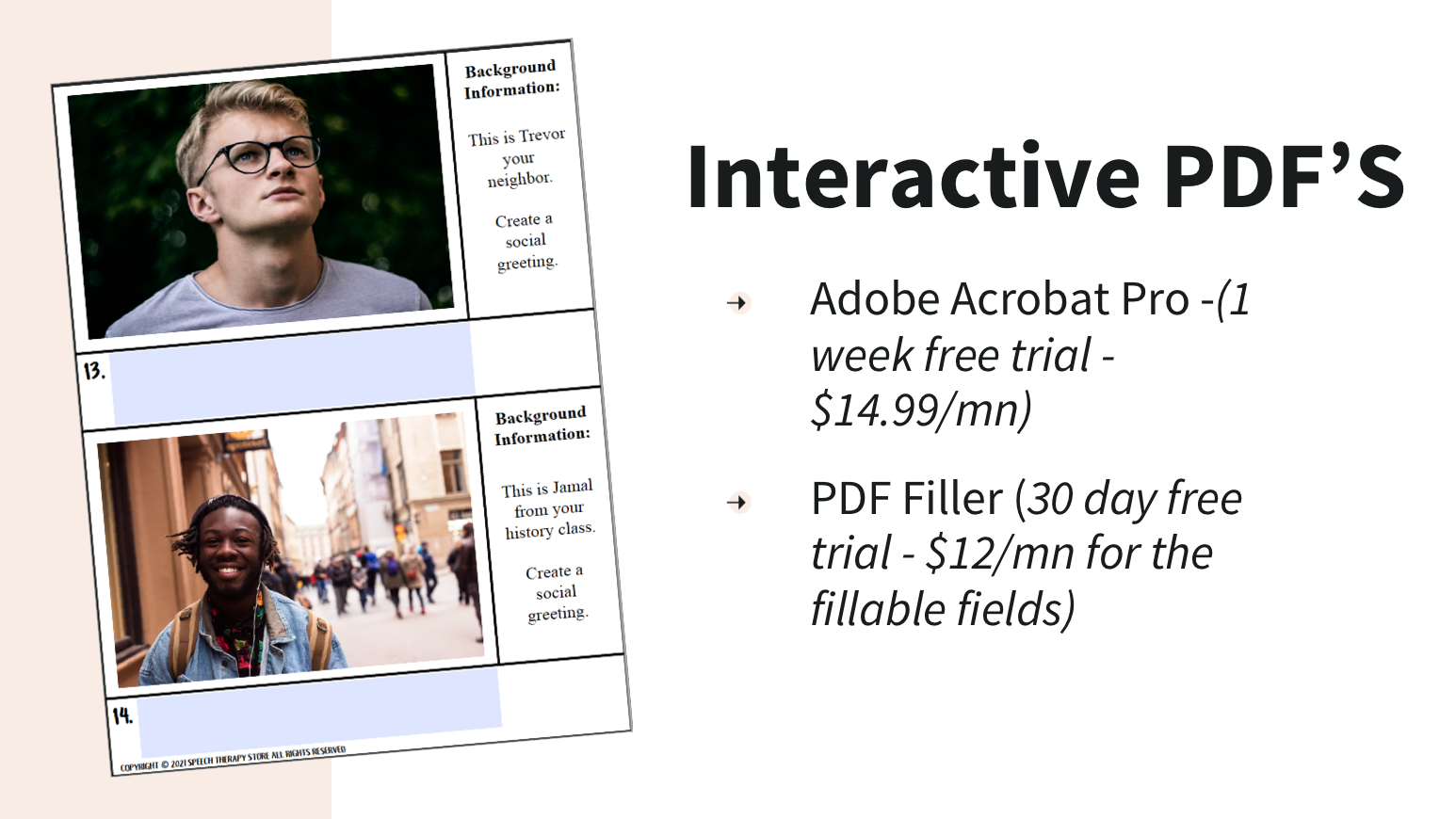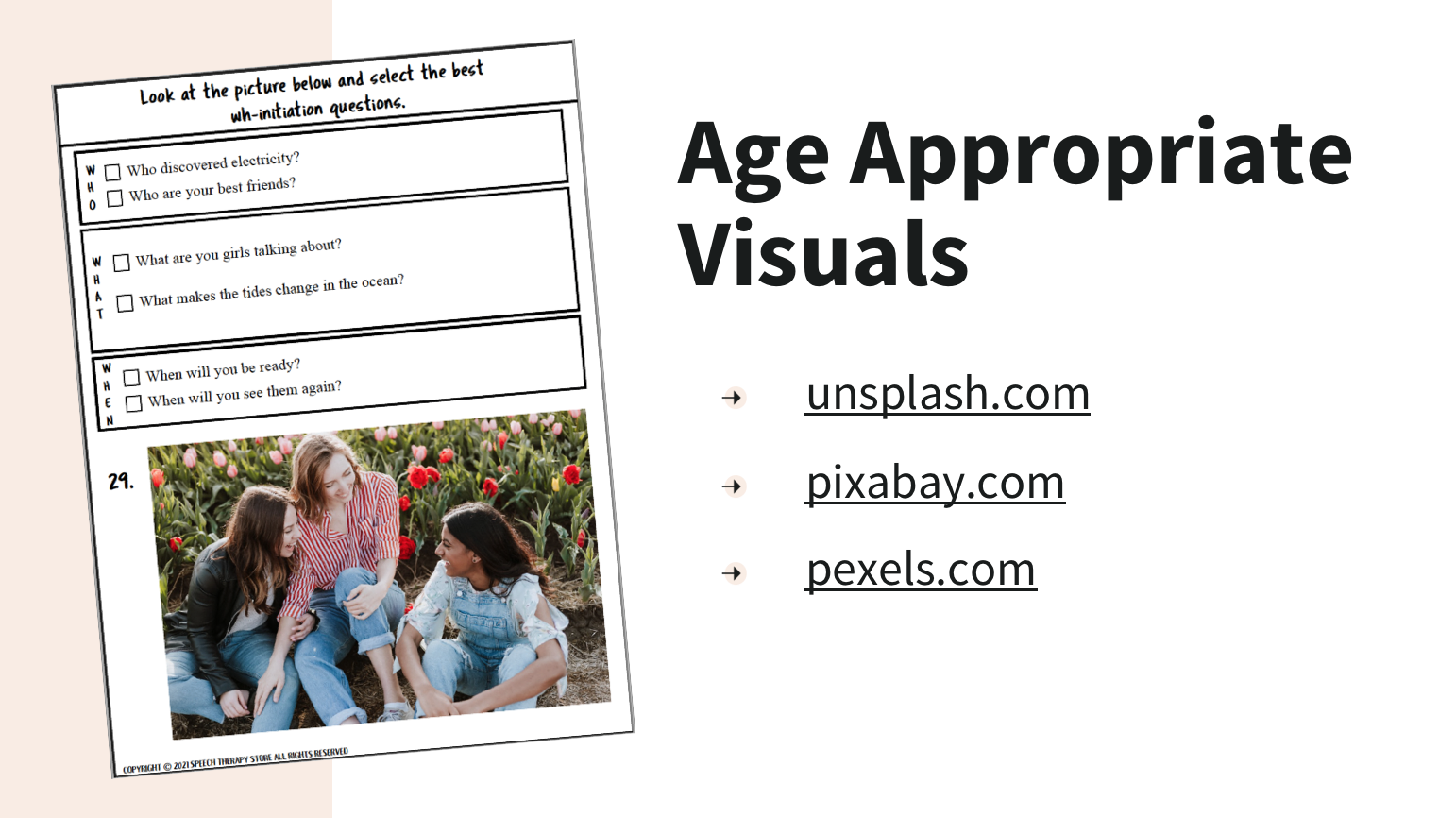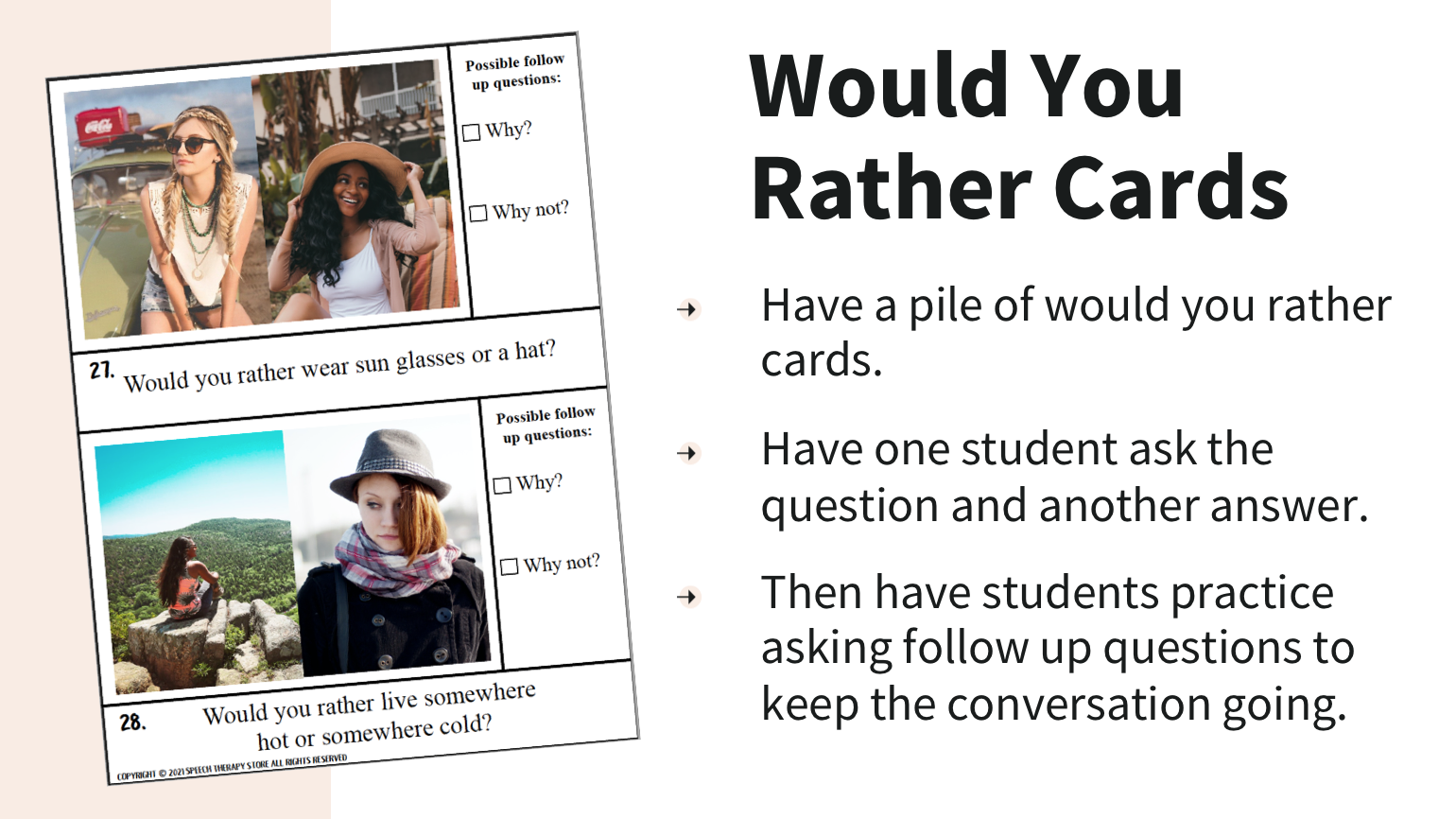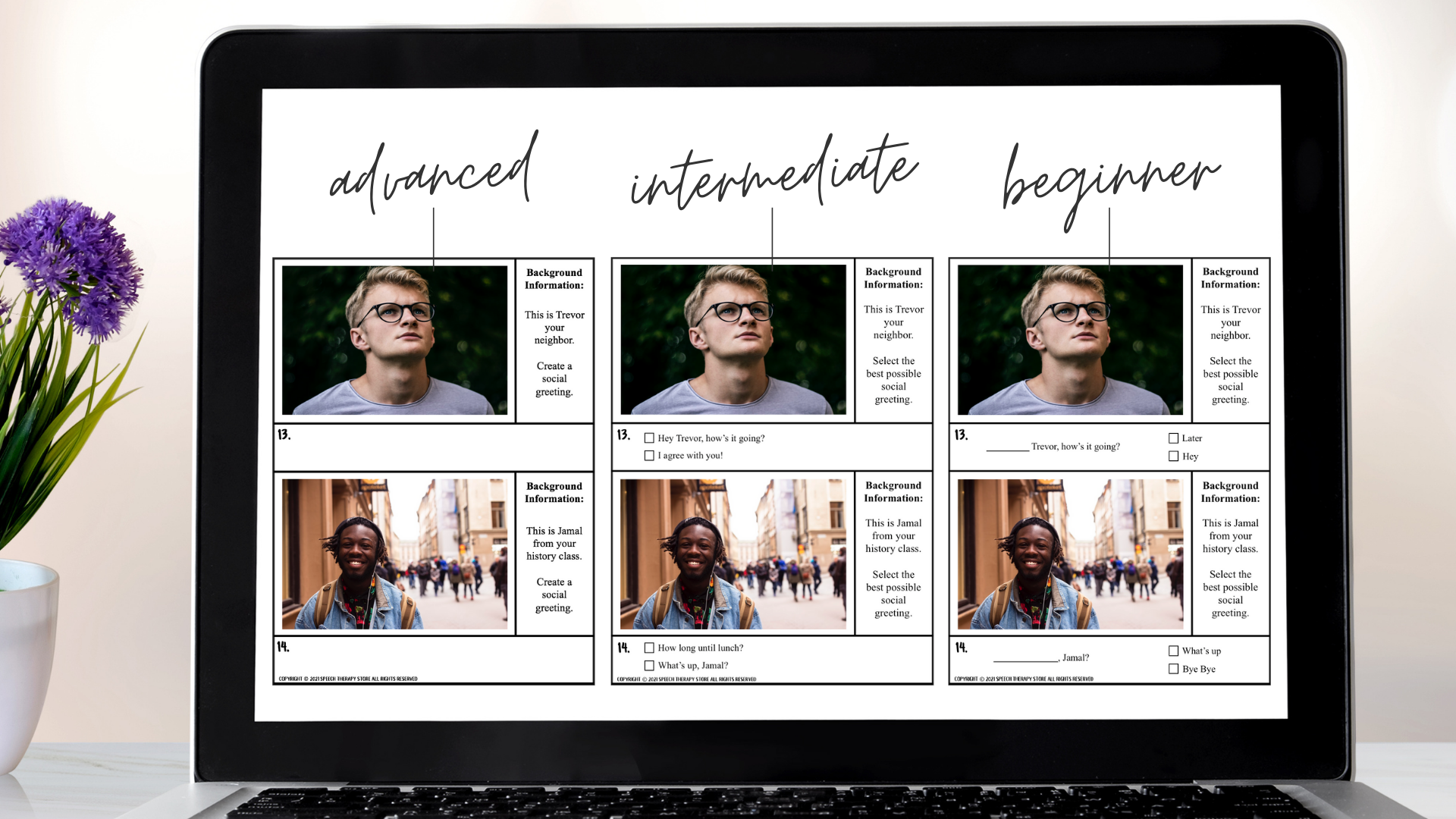Do you need ideas to…
- help maintain your students attention when practicing conversational skills with their peers?
- get and keep your students attention on the conversation?
- have your students stay engaged or ‘in the present’?
- keep your students engaged in topics that don’t interest them?
- help find activities that will keep their interest and focus?
- simply keep your students focus, because you are continually redirecting them to stay on point?

#1 – Using Interactive PDFs to Increase Engagement
Using interactive PDFs is one of my newest favorite ways to make my materials more fun and engaging. This is best when working on a specific skill when teaching conversational skills, such as greetings or making comments.
Interactive PDFs allow your students the ability to type out their answers or use check boxes to help keep them involved in the discussion.
This digital format can also come in handy when you have a larger group and are trying to keep everyone engaged and involved. If everyone has to type down their answers I can have the student who are done first share their answers while the other students are continuing to work on the assignment.
In addition fillable PDFs can also be a great addition to send home for homework or generalization skills for those families that don’t have access to a printer or simply don’t want to print out endless worksheets from home.
You can also easily share your students completed work with another therapist, classroom teacher, or parent in order to keep everyone up to date about what the student is working on.
If you’re interested in turning your favorite static (meaning non-interactive) PDF into an interactive PDF here are two paid programs that you can use to do so. Personally I use Adobe Acrobat Pro.
- Adobe Acrobat Pro (1 week free trial – 14.99/mn)
- PDF Filler (30 day free trial – $12/mn for fillable fields)

#2 – Use Age Appropriate Visuals
Do you ever find yourself saying any of the following?
- The materials are too primary looking for my middle school students, such as using primary pictures or events; playground, recess, or even toys.
- I need real photos and real scenarios for teens and young adults.
- I have high schoolers I don’t want childish looking graphics.
How many times have you looked for age appropriate materials that include real photos and real scenarios for teens and young adults only to find primary looking materials and graphics for teaching conversational skills?
I can totally relate!
There aren’t a ton of options out there, but I’m going to share with you place where you can find free age appropriate visuals to use with your lessons.
Here are my top three:
- unsplash
- pixabay
- pexels

#3 – Google Internet Pens
Have you heard of a google internet pen? They are pretty awesome!
There are different chrome extensions you can download to use as a pen on the internet, which allows you to write on any page on the internet.
One of my favorite ways to use this tool is on an image or video to pause and draw and bring the students attention to different parts of the video.
For example, circling facial expressions, or drawing a line from the person’s eyes to where they might be looking.
My students love being able to draw directly on a Youtube video or image that we come across on the internet.
- Download Paint Tool – Marker for Chrome Extension

#4 – Use a Game Format
This strategy is one of my favorites because it allows me as the therapist to feel like we’re actually working on my students goals while having FUN.
Example #1 – Teaching Tone of Voice

When I’m working on Tone of Voice with my students here is a game we like to play to practice this skill.
I have a set of emotion cards (be sure to have them keep this card a secret from their peers) and a set of random one sentence notecards.
The students then take turns drawing one emotion card and one sentence card.
One at a time students are then instructed to say their sentence out loud in the tone of voice that will get their peers to then guess their secret emotion card.
The other students in the group then try to guess the other students emotion through only their tone of voice.
This game always creates some very funny and silly sounding sentences that my students always seem to enjoy.

For example, trying to be joyful while saying the sentence, “I wish it wasn’t raining outside!” can lead to some awesome giggles.
Example #2 – Teaching Initiating
Do you have a copy of the game Spot It laying around somewhere?
Another example of a game I’ve played is to use the Spot It Game to work on initiating conversations.
The game is played when the first person can spot the same exact image that is on two different cards.
I then have the student who spots the same image in both cards initiate a conversation using the image they spotted to create a topic.
For example, in the image below the purple converse shoe is the same image in both Spot It cards.
The first student to identify the purple converse would then need to initiate the conversation using a topic started about the purple shoes.
They might say something like, “Did you know that Nike owns Converse?”

Example #3 – Teaching Follow Up Questions
Do you have a set of Would you Rather cards or have news articles with topics worth debating?
Here is another fun example of a game format you can use to practice asking follow up questions.
Grab a set of Would you Rather cards or do a quick google search and have your students ask each other Would you Rather questions while practicing asking follow up questions.

Or have any good news articles that your students might enjoy debating?
“Should all the vending machines be removed from high schools? Why or why not?”
Have your students practice keeping the conversations going by asking follow up questions.

There are of course many more game ideas out there that you can use to make your conversational skills lesson plans more engaging, but these are just three ideas of what’s possible and how you can take a game format and use it to make your lessons more fun and engaging.
#5 – Use Materials Differentiated to Your Students Level
I know this one sounds obvious…but hear me out.
I still think it’s important to mention, because this has a lot to do with a students ability to stay engaged in a lesson.
If a material is too high or even too low this can drastically decrease a students ability to remain engaged in an activity for an extended period of time.
Especially when you’re working on a skill that the student finds difficult or boring in the first place.

Do you find yourself thinking…
- these materials are great, but not at the level I need based on my students.
- this is not a material low enough for my “beginners” to access.
- almost everything that is on a simple level is geared toward younger children.
- materials are often either too developmentally high for student’s level or too low to engage them.
- materials are often geared to one person and might be too low or high for others.
I feel like as SLPs this is one of our super power. We know how to differentiate materials and use visuals, models, and prompts.
So I won’t go into the different ways in which to differentiate, but if you’re looking for an all in one solution to teach conversational skills to your middle and high school students with differentiated lesson plans already done for you then be sure to click the link below to learn more about having your conversational skills lesson planning done for you.
Wish You Could Find Materials Like These Already Made For YOU?
Are you thinking I’m loving all these ideas, but who has time to implement and create all these materials?
I just wish you would do it all for me!

When you envision this school year what if I told you that you could have your entire year of Conversational Skills Lesson planning for your Middle and High School students done for you using a laid out for you lesson plan?
Well then you’re dreams have come true, because I’ve got a surprise for you. Click the link below to learn more.
<<CLICK HERE TO LEARN MORE!>>
An entire years worth of lesson planning done for you for Middle and High School aged students working on Conversational Skills. Plus there’s a bonus, or two, or three. Be sure to click the link above to see more.
In Conclusion if you Need Ideas to…
help maintain your students attention when practicing conversational skills with peers or to keep your students engaged in topics that don’t interest them here are a few ideas to try.
- #1 – Use Interactive PDFs
- #2 – Use Age Appropriate Visuals
- #3 – Google Internet Pens
- #4 – Use a Game Format
- #5 – Use Differentiated Materials
Which idea is your favorite?
<<SAVE YOUR FAVORITE PIN!>>



Need More Speech Therapy Ideas and Materials
Be sure to check out the following topics for more ideas!
